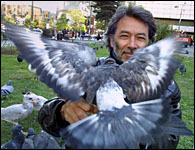(A not so) bird-brained idea
It was once believed that the function of the brain was to cool the blood. That theory went extinct before the dodo, but despite the now-accepted theory that the brain is involved in processes of thought, we are still little further ahead in unlocking many of its mysteries. Professor Louis Lefebvre and his team of researchers in McGill's Department of Biology have been studying the evolution of intelligence for the past seven years. By focusing on innovative bird behaviours, they have managed to shed light on some of the mind-bending questions that have perplexed scientists for centuries.
 Professor Louis
Lefebvre and a feathered friend Professor Louis
Lefebvre and a feathered friendPHOTO: Owen Egan |
|
|
|
|
Since the early 1800s, scientists had suspected that brain size was linked to intelligence. German neuroanatomist Franz Joseph Gall suggested that organisms with a large brain relative to body size might be of greater intelligence than those with a smaller brain. The theory sounded reasonable, but until recently a suitable method of testing this idea had eluded scientists. Intelligence is particularly difficult to define, let alone measure.
"Previous attempts to establish animal intelligence used standardized IQ-style tests, which were unfair to certain species and out of touch with real-life situations," explained Lefebvre. "We had to find a whole new way of measuring intelligence." Lefebvre developed a new, unbiased method of measurement by recording the ability of animals to find solutions to problems in a natural setting - to innovate and learn in the wild.
In 1994 Lefebvre started to collate reports of wild bird innovation to investigate the relationship between brain size and intelligence. "Birds are incredible innovators," explained Lefebvre. "People love to bird watch and record these behaviours." Nowhere is this more apparent than in Britain, where membership in the Royal Society for the Protection of Birds is nearly four times greater than membership in Tony Blair's ruling Labour Party. The scientific journal British Birds devotes numerous pages to observations of novel bird behaviour provided by amateur enthusiasts and scientists alike. Much like the game of cricket, the British love of birds spread through many of the Empire's former colonies and, consequently, abundant examples of bird innovation are noted around the world.
Lefebvre has documented over 2,000 new innovations from more than 500 different bird species, with the most reported ones being feeding behaviours. A commonly cited example is that of the European blue tit. In Britain, where milk is delivered to household doorsteps, blue tits are commonly found opening the tin foil bottle caps in order to feed on the cream. Other examples may be less familiar but equally, if not more, remarkable: New Zealand house sparrows gain access to cafeteria food supplies by triggering the motion sensor that opens the door. Australian skua feed alongside elephant seal pups on the milk from their lactating mother. Green-backed herons from around the world use bread and insects as bait to catch fish.
Using innovation re-ports like these, Lefebvre has been able to rate bird groups according to their intelligence and confirm a positive correlation be-tween brain size and intelligence in birds. "The common crow has one of the highest brain to body size ratios," said Lefebvre. Taking into account total body weight difference, the crow's brain is about five times larger than that of a pigeon.
So what are the world's most intelligent birds? Woodpeckers rank high in the bird smarts pecking order. For example, the gila woodpecker found in the southwest USA and Mexico fashions a wooden scoop out of tree bark to carry honey home to its young.
Birds of prey - hawks, eagles, falcons - are also bright. Bald eagles in northern Arizona have discovered that dead minnows lie frozen under the surface of ice-covered lakes. On lakes where the ice is thin, eagles can be found chipping holes in the surface. This alone isn't enough to earn them their meal, however; the eagles then jump up and down on the surface of the ice, using their body weight to push the minnows up through the holes.
The most intelligent bird group according to Lefebvre's research is crows. The Japanese carrion crow exhibits a remarkable behaviour that demonstrates why this bird is at the top of the "bird brain" charts. At a university campus in Japan, carrion crows have developed a unique feeding innovation that exploits human technology. They perch at traffic intersections and patiently wait for the red light. When the vehicles come to a stop, the crows spring into action - they fly down to the cars and place walnuts under the tires. These crows are smart enough to have figured out that the simplest way to open a nut is to get someone else to do it for you.

